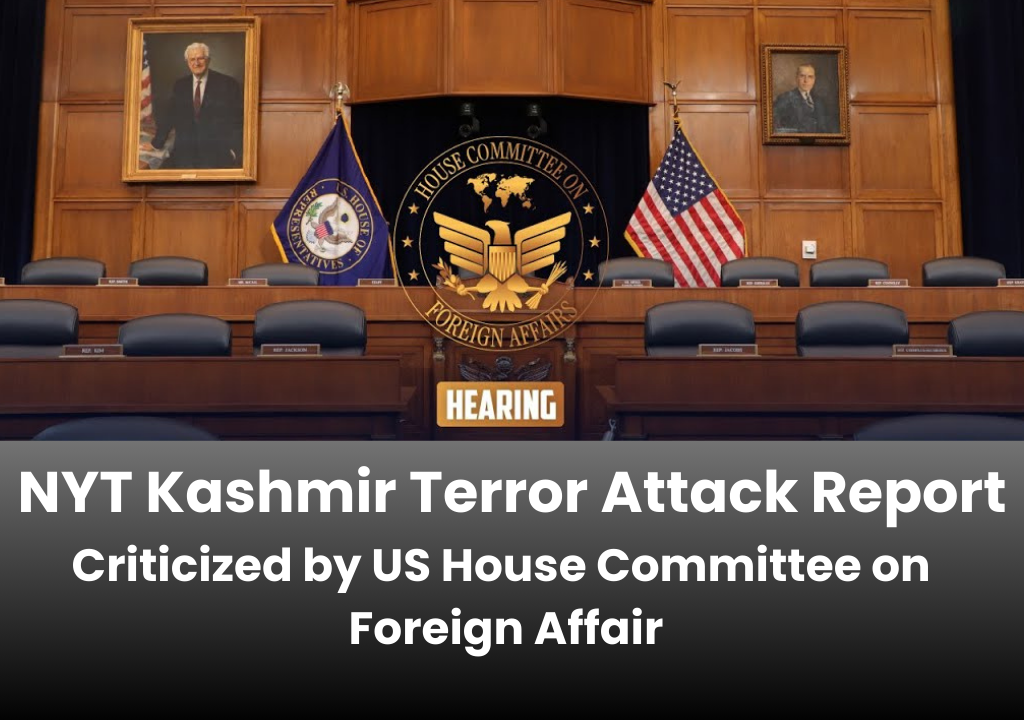Introduction
The NYT Kashmir Terror Attack report has sparked global outrage after the US House Foreign Affairs Committee slammed The New York Times for misrepresenting a deadly act of terrorism in Jammu and Kashmir. The incident, which occurred in Pahalgam and claimed the lives of 26 people, including a foreign national, was reported by NYT as a “militant shooting”—a choice of words that many saw as downplaying the gravity of the act. In a strongly worded response, the US government described it unequivocally as a “terrorist attack, plain and simple.”
This public rebuke reignites debate over the Western media’s portrayal of terrorism in South Asia and raises concerns about bias in international journalism.
What Was Reported?
The New York Times article on the Pahalgam incident used the term “militants” instead of terrorists, suggesting that Prime Minister Narendra Modi’s labeling of the attack as “terrorism” was merely his interpretation.
The headline read:
“At Least 24 Tourists Gunned Down by Militants in Kashmir.”
The phrasing implied a lack of certainty about the terrorist nature of the incident, which many viewed as downplaying the brutality and ideological intent of the attackers.

US Panel’s Response
The US House Foreign Affairs Committee was quick to respond via social media, directly criticizing the NYT’s language. In a post, it declared:
“This was a terrorist attack, plain and simple… Whether it’s India or Israel, when it comes to terrorism, the NYT is removed from reality.”
They even shared a “corrected” version of the NYT headline, sarcastically captioned:
“Hey NYT, we fixed it for you.”
This public call-out signals growing dissatisfaction with how major Western media outlets frame terrorist incidents in non-Western regions, especially in South Asia.
Links Suggested: India-Sri Lanka Relations : 5 Strategic Wins for Both Nations
Difference Between Militants and Terrorists
Understanding the terminology is key. The word militant often refers to individuals involved in domestic armed conflict for political or ideological purposes. Terrorism, however, involves calculated, fear-driven violence, typically with external support, aimed at destabilizing societies.
In this case:
- The Resistance Front (TRF), which claimed responsibility, is an offshoot of the UN-designated terrorist group Lashkar-e-Taiba.
- TRF has direct links to Pakistan-based operations, aligning it with global terrorism, not local militancy.
India’s Stand on the Attack
Following the attack, India held a high-level Cabinet Committee on Security (CCS) meeting chaired by Prime Minister Modi. The government statement emphasized:
“Cross-border linkages of the terrorist attack were confirmed. This attack follows the peaceful conduct of elections and steady economic development in the Union Territory.”
This suggests that Pakistan-based groups are attempting to disrupt India’s democratic and developmental progress in Jammu and Kashmir.
Links Suggested: Digital India and Cyber Security: Balancing Innovation and Protection
Western Media’s Double Standards
Analysts have long noted the selective terminology used by Western media:
- Russia’s Ukraine invasion is labeled as exactly that—an “invasion.”
- Pakistan’s aggression in Kashmir, however, is often described as a “dispute,” despite clear evidence of infiltration and proxy warfare.
This inconsistent framing raises concerns about bias, especially in influential publications like NYT. Critics argue that such language:
- Delegitimizes India’s security concerns
- Normalizes extremist violence in South Asia
- Fuels geopolitical misinformation
Historical Context: Pakistan’s Invasion of Kashmir
To understand current tensions, one must revisit 1947. After Partition, Pakistan was formed on the Two-Nation Theory, rooted in religion rather than ethnicity or language.
- Jammu and Kashmir, a princely state, chose to accede to India through a legal Instrument of Accession.
- In response, Pakistan invaded using tribal militias, followed by regular troops—marking the first act of aggression, now termed Pakistan-occupied Kashmir (PoK).
- Areas like Gilgit-Baltistan were thus illegally occupied, a fact recognized in many Indian and international assessments.
This history is crucial in understanding why India calls these attacks “terrorism”, not local unrest or militancy.
Conclusion
The NYT Kashmir terror attack report has sparked global debate not only about terrorism but also about how media outlets choose their words. The US House Foreign Affairs Committee’s rebuke reflects a growing international consensus that terror should be called what it is—terrorism.
This incident once again highlights the importance of fact-based, unbiased reporting, especially on sensitive global security issues. As India continues to face cross-border terrorism, global media must reflect truth over political correctness.

